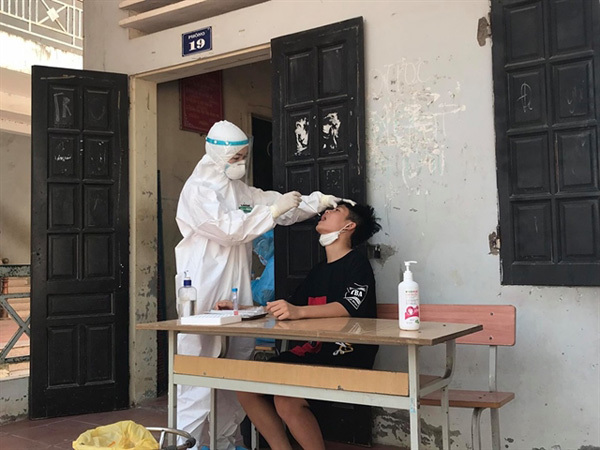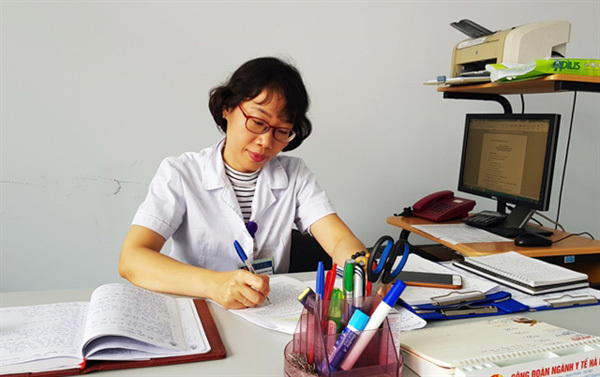 |
| A health worker in Hanoi's Phuc Tho District taking sample for COVID-19 testing of a person travelling from Da Nang City. — VNA/VNS Photo |
“It was about 3am on August 7. I got a phone call from the Hanoi Centre for Disease Control informing me there was a SARS-CoV-2 positive case in Hamlet 2 of Van Phuc Commune,” Hung recalled.
“Although I was ready to prepare myself for the pandemic, at that time I couldn't help feeling nervous. Immediately, I called to report to the district’s Steering Committee for Pandemic Prevention for urgent zoning and quarantining,” Hung said.
District health workers and the rapid response force went to work.
When the teams reached the patient’s family's street, it was about 4am. Everything was still quiet and the whole block of houses was still asleep.
The health workers and local authorities immediately looked at the field for plans to zone off the area. The patient's family woke up and opened the door for the teams, Hung said.
“When I informed them one of their family members had tested positive for the virus, they were a little bit panicked,” Hung said.
“So we had to keep them calm, do the patient’s epidemiological investigation, carry out procedures to send the patient to the National Hospital of Tropical Diseases and disinfect the house and neighbouring areas,” he said, adding this took them more than an hour.
The rapid response teams also started the health monitoring measures by informing the people around and tracking those who had contacted the patient, he added.
Quick tracing and zoning
Since the second wave of the COVID-19 pandemic hit in Da Nang City in July, the district's rapid response teams have been working day and night, tracing cases and taking samples for testing.
Over the past month, the teams started working at 7am at a testing facility in the yard of Tam Hiep Commune Secondary School.
In the hot and humid weather, the staff had to wear protective suits from head to toe, making for hot and sweaty work.
They did not complain and worked diligently to take samples and determine the epidemiological history of people who had returned from Da Nang.
As a head of five rapid response teams, Hung arrived at the testing place very early every day to supervise the work.
For Hung and his teams, the past days were full of stress, pressure and anxiety.
Since Phuc Tho District recorded the first COVID-19 case, the health workers knew that day or night, wherever there was a risk of infection, the "white-blouse warriors" would have to go, he said.
So far, a total of 623 people returning from Da Nang have had their samples taken for testing.
“Even in emergency situations, the rapid response teams always followed professional anti-epidemic procedures. Thanks to that, after the first case, there were no new cases,” Hung affirmed.
Previously, the district’s health workers participated in the testing process in Ha Loi Hamlet of Me Linh District when the first wave of pandemic occurred in mid-April, and that experience helped them react quickly for the second outbreak.
Work hard in protection suits
For those who perform the testing as technician Giang Thi Binh from the diagnostics faculty of Hanoi's Phuc Tho District medical centre, each disease outbreak is a new war.
Her job is full of risks because of her close contact with suspected cases and COVID-19 patients.
While working, all personal needs must be put aside in a tight protective suit.
"Thirsty but could not drink. Itching but could not scratch. It was very uncomfortable in the protective clothes but everyone got used to them,” Binh said.
When the shift finished and it was time to take off the suits, Binh was covered in sweat. She quickly drank some water, went to the toilet and found a place for a short break.
“When informed about suspected cases, my task was to come there and take samples. I was always in a ready state,” Binh said.
“Procedures must be implemented quickly and accurately. The samples were quickly stored in cold boxes to send for testing,” she said.
Each time they went to households to take samples, the medical staff must change into new protection suits to ensure safety. This was time-consuming.
“There were days that I had to work and go to many families. I had to change into more than a dozen protective suits,” said Binh.
“The whole day to collect samples was ‘breathless’ but it was not the end of the task. The job of the testing technician also includes matching the codes and sending the samples to Hanoi’s Centre for Disease Control for testing,” she said.
Some days, Binh had to line up until midnight to send samples and finished work at 1 or 2am of the next day.
“At that time, I suddenly remembered I had not contacted my two young children for a whole day, who I had to send to my grandparents to take care of when participating in the anti-pandemic campaign,” the female technician said.
There were times the "white-shirt warriors" felt exhausted, tired and wanted to rest but seeing other colleagues nationwide fighting every day, they had more motivation.
The COVID-19 pandemic may last for a long time, but health workers are strong of spirit and are ready to fight day or night. VNS

Hard-working technicians at Da Nang lab seek COVID-19 infection cases
The Da Nang Centre for Disease Control and Prevention (CDC) has been busy on the frontline in the fight against COVID-19 over the past 10 days due to Da Nang’s administration accelerating mass testing.

Devoted doctor in the fight against COVID-19
Tran Thi Phuong Anh, 45, a doctor of Hai Ba Trung District’s Medical Centre, Hanoi, has been a bit busier than usual since the COVID-19 pandemic hit the city earlier this year.